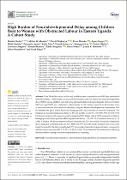| dc.contributor.author | Chebet, Martin | |
| dc.contributor.author | Musaba, Milton W. | |
| dc.contributor.author | Mukunya, David | |
| dc.contributor.author | Makoko, Brian | |
| dc.contributor.author | Napyo, Agnes | |
| dc.contributor.author | Nantale, Ritah | |
| dc.contributor.author | Auma, Proscovia | |
| dc.contributor.author | Atim, Ketty | |
| dc.contributor.author | Nahurira, Doreck | |
| dc.contributor.author | Lee, Seungwon | |
| dc.contributor.author | Okello, Dedan | |
| dc.contributor.author | Ssegawa, Lawrence | |
| dc.contributor.author | Bromley, Kieran | |
| dc.contributor.author | Burgoine, Kathy | |
| dc.contributor.author | Ndeezi, Grace | |
| dc.contributor.author | Tumwine K., James | |
| dc.contributor.author | Wandambwa, Julius | |
| dc.contributor.author | Kiguli, Sarah | |
| dc.date.accessioned | 2024-04-05T09:14:28Z | |
| dc.date.available | 2024-04-05T09:14:28Z | |
| dc.date.issued | 2023-02-16 | |
| dc.identifier.issn | 1660-4501 (Online) | |
| dc.identifier.uri | https://doi.org/10.3390/ijerph20043470 | |
| dc.identifier.uri | http://hdl.handle.net/20.500.12280/3113 | |
| dc.description.abstract | Over 250 million infants in low and middle-income countries do not fulfill their neurodevelopment potential. In this study, we assessed the incidence and risk factors for neurodevelopmental delay (NDD) among children born following obstructed labor in Eastern Uganda. Between October 2021 and April 2022, we conducted a cohort study of 155 children (aged 25 to 44 months), born at term and assessed their neurodevelopment using the Malawi Developmental Assessment Tool. We assessed the gross motor, fine motor, language and social domains of neurodevelopment. The incidence of neurodevelopmental delay by 25 to 44 months was 67.7% (105/155) (95% CI: 59.8–75.0). Children belonging to the poorest wealth quintile had 83% higher risk of NDD compared to children belonging to the richest quintile (ARR (Adjusted Risk Ratio): 1.83; 95% CI (Confidence Interval): [1.13, 2.94]). Children fed the recommended meal diversity had 25% lower risk of neurodevelopmental delay compared to children who did not (ARR: 0.75; 95% CI: [0.60, 0.94]). Children who were exclusively breastfed for the first 6 months had 27% lower risk of neurodevelopmental delay compared to children who were not (ARR: 0.73; 95% CI: [0.56, 0.96]). We recommend that infants born following obstructed labor undergo neurodevelopmental delay screening. | en_US |
| dc.language.iso | en | en_US |
| dc.publisher | MDPI | en_US |
| dc.relation.ispartofseries | International Journal of Environmental Research and Public Health;2023, 20(4), 3470 | |
| dc.subject | Neurodevelopmental delay | en_US |
| dc.subject | Growth | en_US |
| dc.subject | Eastern-Uganda | en_US |
| dc.subject | Thrive | en_US |
| dc.subject | Development | en_US |
| dc.subject | Nutrition | en_US |
| dc.title | High burden of neurodevelopmental delay among children born to women with obstructed labour in Eastern Uganda: a cohort study | en_US |
| dc.type | Article | en_US |


